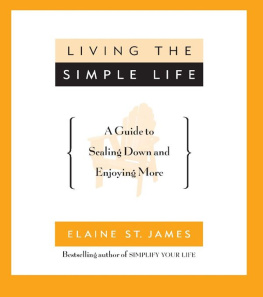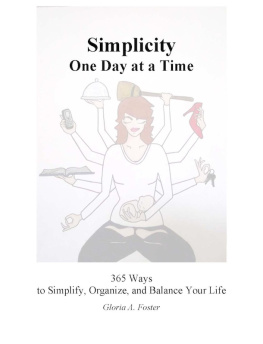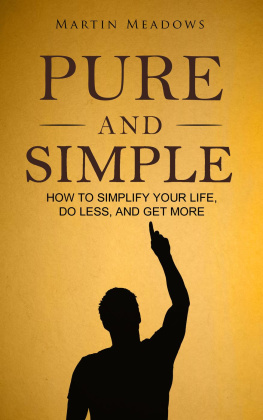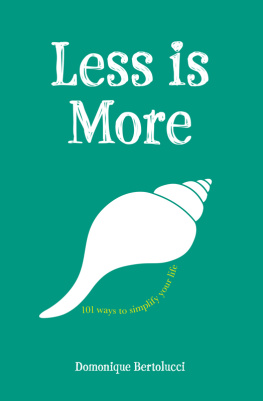I d like to thank Marcia Burtt, Dave Sowle, Marisa Kennedy Miller, Jackie Powers, Judy Babcock, Phil Babcock, Jim Cummings, Meg Torbert, Linda Miller, Albert Chiang, and Ira Weinstein for their support and encouragement in the writing of this book. Id like to thank Felix Fusco, Sue Pettengill, Cyndy Van der Poel, Hope Kores, Kathy McDonough, Beverly Brennan, my mother, Dorothy Kennedy, and my favorite aunt, Kathleen Schiffler, for always being there. Id like to thank Sam Vaughan for his advice and inspiration, and for connecting me with my wonderful agent, Jane Dystel. And most of all, Id like to thank my husband, Wolcott Gibbs, Jr., for everything.

Let your boat of life be light, packed with only what you needa homely home and simple pleasures, one or two friends worth the name, someone to love and someone to love you, a cat, a dog, and a pipe or two, enough to eat and enough to wear, and a little more than enough to drink, for thirst is a dangerous thing.
J EROME K LAPKA J EROME
S everal years ago I was sitting at my desk, idly glancing at my daily schedule, which was laid out in a time-management system roughly the size of Nebraska. This binder was bursting with to-do lists, phone logs, time-organizers, meeting-maximizers, goal-stabilizers, high-tech efficiency charts, and five- and ten-year life planners. Suddenly, I realized I no longer wanted my life to be that complicated.
I immediately picked up the phone and scheduled a long weekend retreat. I left my time-management system at home, but I took a notebook. I had a lot of thinking to do.
Like many others of our generation, my husband, Gibbs, and I had bought into the Bigger is Better and the More is Better Yet philosophies of the 1980s. We had the big house, the big car, most of the conveniences, and many of the toys of the typical yuppie life-style. Then we gradually began to realize that, rather than contributing to our lives, many of these things complicated them far more than wed been willing to admit. Wed always known the Joneses werent worth keeping up with, but we finally had to face the fact that the only thing wed ever gotten from a power lunch was indigestion. The time had come for us to get off the fast track.
Over the next few days I sat alone in the peaceful silence of that retreat house, and came up with a list of things we could do to improve the quality of our lives while decreasing the complexity. When I got home, I sat down with Gibbs and went over the list. Fortunately, he agreed with all of the major and most of the minor changes I proposed.
The first thing we did was get rid of all the stuff we didnt use anymore (#1). We took a giant step and moved across country, so we could work where we wanted to live (#51), and do what we really wanted to do (#52). In the process we moved to a smaller house (#19). Over the next few years we simplified our eating habits (#57), consolidated our investments (#46), sold the damn boat (#21), rethought our buying habits (#40), and drastically reduced our needs for goods and services (#42). Step by step, we gradually implemented most of the ideas outlined in this book.
When we launched our simplicity program, we had three specific goals in mind. First, we wanted the things in our livesour home, our cars, our clothes, our diets, our financesto be small enough and few enough and simple enough that we could easily take care of them ourselves.
Second, we wanted to free ourselves from the commitments, the people, and the obligations that kept us from having time to do the things we really want to do. We made the decision early on to stop doing the things that wed always done because we felt we should do them. Not only has this increased the time we have for ourselves, but it has greatly reduced the stress that comes from doing things we dont want to do.
Third, we wanted our lives to be consistent with our desire to live in harmony with the environment.
For us, simplifying was not the going back to the land movement of the 1960sthough we did want to include more nature in our lives, and we have. Nor was it about living cheaply, though close to half of the suggestions in this book will reduce your expenditures. For us, living simply meant reducing the scale, maintaining the comfort, eliminating the complexity, and minimizing the time demands of life as we had known it in the 1980s.
When we first started to simplify, I longed for guidance from others who had been there before us. I combed libraries and bookstores in search of help. While a fair amount has been written about the philosophy of the simple life, I was unable to find anything of a practical nature that outlined specific things we could do to simplify. So we plodded along on our own.
Each time we completed a major step in our simplification process, we discovered some other minor things we could do to simplify, and we added them to our list. I decided that if the two of usfor the most part rational and reasonable peoplehad gotten so caught up in the frenetically paced lifestyle and rampant consumerism of the eighties, there must be other reasonable people out there who had done the same thing, and who were now looking for practical things they could do to simplify their lives. And so I decided to write this book, which is a compilation of those steps weve taken to simplify, and the things weve learned from other like-minded people along the way.
Its possible your life is complicated enoughas ours wasto warrant implementing many or all of these suggestions. Or, it might be that taking just one or two of these stepslike cleaning up your relationships (#72), or changing your expectations (#88)will provide the level of simplicity you need to more fully enjoy the other areas of your life. Whatever the case, keep in mind that one persons simplicity is anothers complexity. Bowing out of the holidays (#33) was tremendously liberating for us, but it might complicate your life beyond words. You get to decide.












